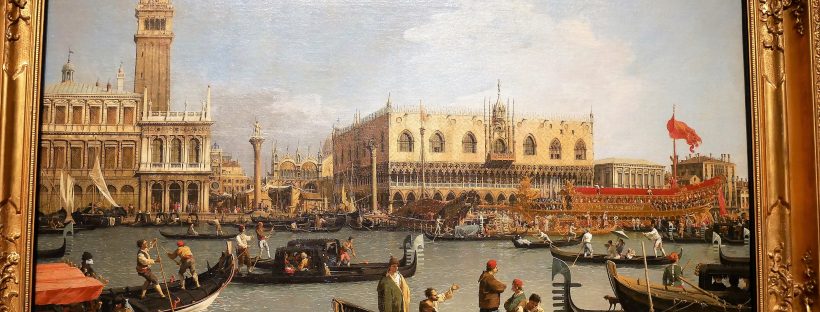The top holiday souvenir when you were on the Grand Tour in the 18th century was a painting by Canaletto as Venice was considered the cultural centrepiece of such an expedition! Luckily for those of us without such deep pockets, the Queen’s Gallery is staging a stunning show called ‘Canaletto & the Art of Venice’ which transports you back to Venice of those days.
The Queen’s Gallery in London holds the world’s finest collection of paintings and drawings by Canaletto thanks to George lll’ s timely purchase of a library and associated works from Joseph Smith, who had fallen on hard times. George was a keen bibliophile and included in his purchase of Smith’s library in 1762 were a Vermeer, Venetian masters and a large number of Canaletto’s paintings, prints and drawings. An unknown figure to me, Smith’s story was fascinating as he was an art dealer, Canaletto’s agent and the British Consul in Venice who supported Canaletto, bought his work and commissioning paintings when Canaletto had fallen out of the spotlight. Smith rebuilt his own finances after he lost his library, began collecting again and lived to the age of 96 when his collection took up 3 days of sales at Christie’s, I do wonder what was in those sales…
Back to Canaletto and the exhibition. We learn about Venice in the 18th century when its political power was ebbing away but economically it was still strong, thriving on income from the Grand Tour visitors, particularly the British. Canaletto’s paintings became how Venice was seen and understood by the world. Born in 1697 in Venice as Bernardo Canal, he was a stage painter and an accomplished draughtsman which can be seen in the precision of his buildings. Accuracy was not always as precise as we assume, as he was prone to moving scenes around to give a better composition than the scene before him.
In the first room of the exhibition, we are hit immediately by the brilliance of 2 of his finest works, classic views of the Grand Canal where regattas and festivals are taking place with Venetians and boats decked out in their finery.
I was particularly taken with this set of 6 drawings of the Grand Canal, unusually not made as preliminary works but are the finished works in their own right. They are pen, pencil and ink drawings, showing his customary attention to detail and a quality of penmanship that was much admired in his day.
Here’s a close up of the drawing from the bottom right-hand corner of the set.
The main gallery has 2 major series of Canaletto’s work and a substantial room is required to give them space to breathe and been seen as a whole series. One of these is his 12 piece set of paintings of the Grand Canal, through which the viewer can travel along the canal, enjoying the views on the way.
Here’s a closer view of the bottom right-hand painting of this magnificent series. We were told a fun story by the wonderful curator, Lucy Whitaker, who showed us around the exhibition, giving us context and insights along with her passion for this artist. One of the series of 12 showed Joseph Smith’s canal side palazzo which was redecorated while the series was being created, so he asked Canaletto to repaint that section to show off his updated palazzo. The perks of being a patron.
On the opposite wall is a series of 5 paintings depicting Rome, which were new to me. Fashion had moved on and the Grand Tour was not so popular and times were hard for Canaletto so Smith commissioned this Rome series to given him some income. Canaletto had been there some years before so he did not return but painted this beautiful set from memory, previous drawings and used the work of others. The sights of ancient Rome leap off the canvas and were one of many highlights of the show for me.
We know that Canaletto moved to England and painted fine views of the Thames after his time in Venice but that’s another story and another show. This one is about Canaletto, Venice and Joseph Smith. It is well worth a visit to see a show that has so much more than I have been able to cover here.
For full details about the exhibition and the Queen’s Gallery click here.
Full disclosure: I was invited to preview this exhibition and therefore, as is customary, my entry ticket was provided.







